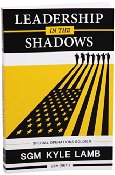
Leadership In The Shadows Special Operations Soldier By Sergeant Major Kyle Lamb
 What do Sun Tzu, Julius Caesar, Antoine-Henri Jomini , Carl Von Clausewitz, and Erwin Rommel have in common? They all wrote books on the science of war from a  “top down†view.1 So great is their fame, that one can easily forget that they did not start out at as Field Marshals and great generals.  Men are not born leaders.  These men, like thousands before them, had to start at the bottom. They first had to learn soldiering and then how to lead groups of soldiers starting at the squad level, and then progressively larger military formations, until they became masters of their chosen profession.  Only after mastering such things could they write books about what they did to reach the pinnacle of their art.
What do Sun Tzu, Julius Caesar, Antoine-Henri Jomini , Carl Von Clausewitz, and Erwin Rommel have in common? They all wrote books on the science of war from a  “top down†view.1 So great is their fame, that one can easily forget that they did not start out at as Field Marshals and great generals.  Men are not born leaders.  These men, like thousands before them, had to start at the bottom. They first had to learn soldiering and then how to lead groups of soldiers starting at the squad level, and then progressively larger military formations, until they became masters of their chosen profession.  Only after mastering such things could they write books about what they did to reach the pinnacle of their art.
Leadership In The Shadows is about what it takes to build such a foundation by learning to command small units. Like every commander, these vaunted theoreticians had to perfect commanding and leading small units, and do it superbly, before they could move on to bigger things. They had to be taught how to lead. Like those who came before and after, they weren’t born with the ability to lead.  These men were probably smarter and quicker to learn than others, but it was experience that allowed them to reach the height of the profession of arms, become famous, and write books instructing others.
This is where Sergeant Major Lamb’s book fills a needed role in the development of the junior leader (like all of those in the first paragraph were at one time). Indeed, Lamb’s book is a “ground up†classic the way the books above are “top down†classics. In his book, Kyle Lamb instructs the new leader and “wanna be leader†on how to guide, lead and motivate the troops under his command.  Unlike the German Army ‘s “Regulation 300-Truppenführung” (Troop Leading) written in 1933, which listed some 1.032 “rules†to follow for the Army, Leadership in the Shadows does not list “rules†to follow in every situation. Sergeant Major Lamb makes it clear that leadership is a flexible and fluid thing and writes from a perspective that can only come from the being in the Army from the bottom up. Lamb shares these principles with the reader as clear, concise and, believe it or not, easy to follow procedures, complete with examples and answers to the ubiquitous “what ifsâ€.
The book is 235 pages long and is divided in to sections on leadership as it relates to action, traits, the mission, future leaders, and the “home frontâ€.  Sergeant Major Lamb even provides you with a “leadership toolboxâ€.
While all of his theories, principles and suggestions fit the military life and some can overlap in to civilian life, not all of them are directly applicable to both.  This reviewer does not agree with SGM Lamb’s premise that all of his work can be used in all aspects of your life without exception. The military is the military and civilian life is civilian life. They are two different tracks which sometimes run in parallel, but more often than not, diverge and have nothing in common.
However, this reviewer can say he wishes he’d had Sergeant Major Lamb’s Leadership in the Shadows when he was starting out in the Army. It would have been been good to have studied it as a Second Lieutenant. As it was, he was a Captain for a few years before he could learn and put into effect much of what is written in Lamb’s book.
Leadership in the Shadows by Sergeant Major Kyle Lamb should be mandatory reading at all our service academies and throughout leadership courses in all our armed services.
This book is probably one of  the best books on leadership at the small unit level ever written. It is destined to be a classic on leadership and will rank, in this reviewer’s opinion, alongside the books mentioned at the start of this article.
1Books Respectively
The Art of War
The Gallic Wars
The Art of War
On War
Infanterie greift an
 The posts are coming!
The posts are coming!

0 comments
Kick things off by filling out the form below.
Leave a Comment